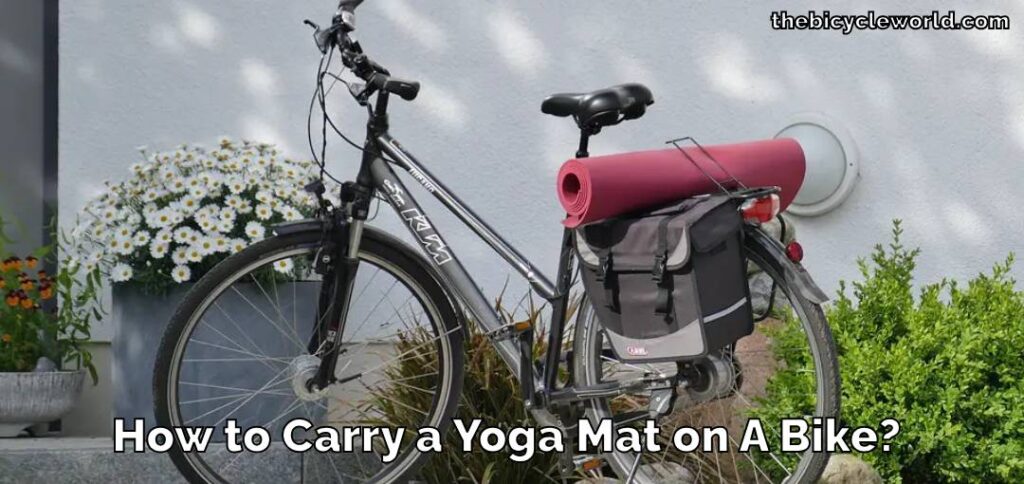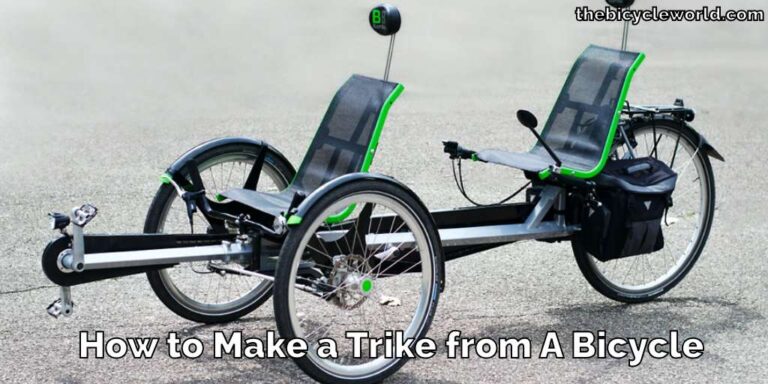How To Carry DSLR Camera On Bike?
Integrating the art of photography into your cycling journey enriches the experience, transforming each ride into an adventure filled with potential photo opportunities. Whether you’re navigating the urban landscape on your road bike on backpacking trips through untouched nature, the presence of a DSLR camera ensures you’re always ready to capture the moment.

This guide How To Carry DSLR Camera On Bike? is designed to seamlessly blend your digital camera with your bike riding experience, ensuring safety, convenience, and quick access to your gear.
How To Carry DSLR Camera On Bike?
The key to a successful integration of photography into cycling is choosing the right storage solution. For digital cameras, especially DSLRs, a bag that offers ample protection against shocks and vibrations is essential.
Whether you’re considering backpacks for road cycling or a dedicated camera pouch, look for options with padded inserts. These inserts play a crucial role in absorbing the jostles and bumps common on bike rides, from smooth road bike paths to the unpredictable terrain encountered on backpacking trips.
Your bike setup for carrying camera equipment should prioritize protection against the elements. Digital cameras, with their sensitivity to dust and moisture, require extra care.
Opting for weather-resistant bags or those with additional covers can be a lifesaver, ensuring your gear remains dry and clean, no matter the weather. For added moisture protection, consider placing silica gel packets inside your bag, a common solution among active photographers.
Mounting your camera bag securely is crucial, regardless of whether it’s attached to your handlebars, frame, or worn as a backpack. Stability is key to preventing damage. Backpacks equipped with a three-point strap system, including an additional sternum strap, offer a secure fit that minimizes movement.
This setup is especially beneficial for backpack solutions on longer bike travel or day cycling content creators who need their gear to be as mobile and stable as they are.
For cyclists who prefer not to wear a backpack, a waist pack or handlebar bag might be the perfect alternative. These options allow for easy access to your camera, ensuring you never miss a photo opportunity.
Waist packs, in particular, have gained popularity among bicycle tourers and cyclists review them favorably for their convenience and the ability to quickly reach for the camera.
Accessibility is another critical aspect of your bike setup. The goal is to have your DSLR camera within easy reach, enabling you to capture those spontaneous moments that make cycling adventures memorable.
Whether it’s a breathtaking landscape or an intriguing urban scene, your setup should allow you to swiftly stop, photograph, and continue on your journey. This balance of security and accessibility is what transforms your bike riding experience into a creative expedition.
By addressing these key aspects—protection, stability, and accessibility—you can ensure a harmonious blend of cycling and photography. Your digital camera becomes more than just an accessory; it’s a tool that captures the essence of your adventures.
From the cycling kit essentials to the items on your cycling bucket list, integrating your passion for photography with cycling allows you to document your experiences in a way that’s uniquely yours.
Remember, the journey of combining bike travel with photography is not just about reaching destinations but capturing the moments that define them. Whether you’re a seasoned cyclist, an aspiring bike-packing enthusiast, or a day cycling content creator.
The ability to bring your DSLR camera along enriches your experience, making every day ride a story waiting to be told. With the right preparation and mindset, your cycling adventures can unfold through the lens of your camera, immortalizing the journey one click at a time.
On-Bike Storage Solutions
Exploring the various on-bike storage solutions for carrying your DSLR camera can significantly enhance your cycling and photography experience. Each option has its own set of advantages, tailored to different types of rides and photography needs.
Handlebar Bags
These are ideal for those who prefer their camera within easy reach. A handlebar bag equipped with a padded insert protects your camera from the vibrations and bumps encountered on the road.
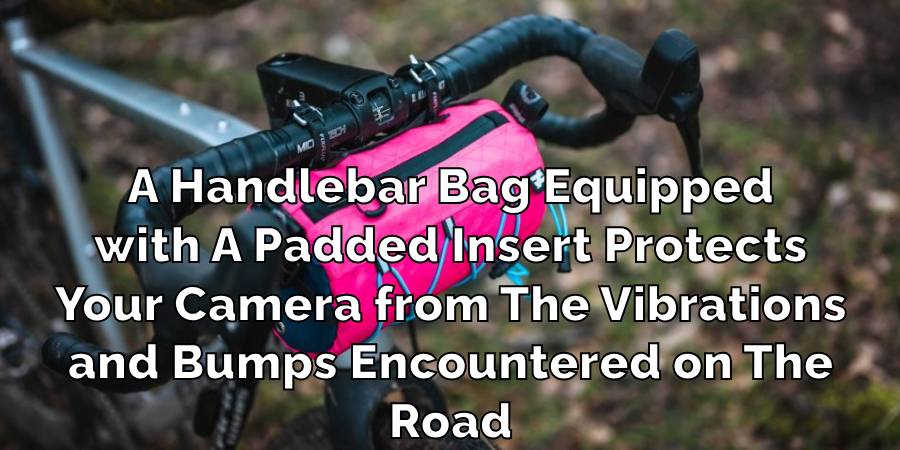
It’s crucial that the bag is securely attached to your handlebars to prevent any swaying or bouncing, which could potentially harm your camera. This setup is perfect for smaller DSLR cameras or mirrorless systems, providing quick access so you won’t miss capturing those fleeting moments.
Look for bags with zippered or magnetic closures for easy one-handed operation.
Frame Bags
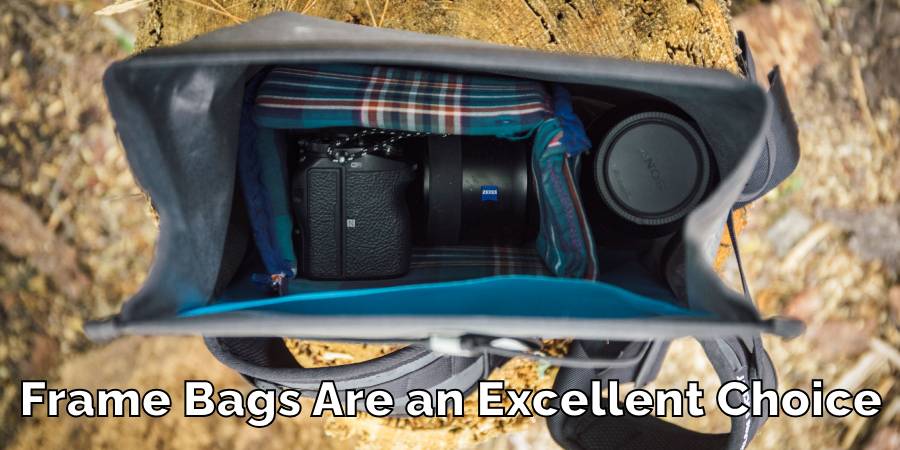
For cyclists concerned about weight distribution and bike handling, frame bags are an excellent choice. Positioned within the bike’s frame, these bags keep your gear’s center of gravity low, minimizing impact on your ride’s stability.
Customizable options are available, allowing you to fit a bag snugly into your frame, offering padded protection for your camera, a lens, and a few other essentials. The key is to choose a design that allows for easy access without requiring you to dismount or stop for extended periods.
Panniers
For longer journeys or when you need to bring along additional lenses and photography gear, panniers are your best bet. Mounted on the rear rack of your bike, panniers with specialized camera inserts provide ample space and protection.

Opting for waterproof panniers adds an extra layer of security against rain and road spray, ensuring your equipment stays dry and functional. While panniers are more suited for touring or lengthy day trips, they offer the peace of mind that all your photography essentials are with you, safe from the elements.
Each of these on-bike storage solutions offers a way to carry your DSLR camera safely and conveniently while you ride. Whether you’re going on a quick jaunt around town, a rugged off-road adventure, or a multi-day tour, there’s an option that fits your needs.
The key is finding the right balance between accessibility, protection, and bike handling so you can focus on enjoying the ride and capturing stunning images along the way.
Wearable Storage Solutions
Opting for wearable storage solutions like camera slings and harnesses can significantly enhance your biking and photography experience. Here’s a deeper look into how these options can benefit you:
Immediate Access
Slings and harnesses keep your camera close to your body, allowing for swift and effortless retrieval. This means you can quickly capture photographs without having to rummage through a bag or backpack.
Whether you spot a breathtaking landscape or an interesting street scene, your camera is always just a moment away from being in hand and ready to shoot.
Stability and Protection
Biking on uneven surfaces can cause significant shaking and vibration, which might pose a risk to your camera. A sling or harness wraps securely around your body, keeping the camera stable and snug against you.
This stability not only reduces the risk of camera shake, resulting in clearer images but also minimizes the chances of impact damage from sudden jolts or if you accidentally bump into something.
Comfort and Ergonomics
Unlike traditional neck straps that can lead to strain and discomfort, especially on longer rides, camera slings, and harnesses are designed with ergonomics in mind.
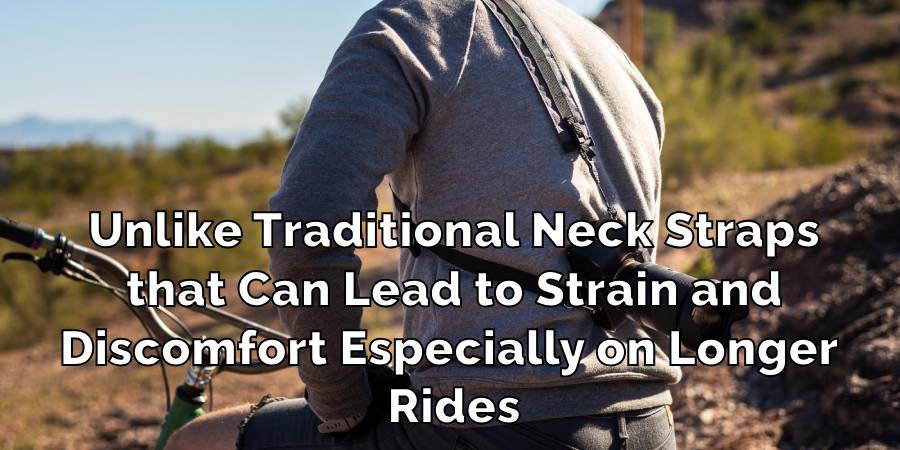
Adjustability for a Perfect FitThey distributes the weight more evenly across your body, making it easier and more comfortable to carry your camera for extended periods. This is particularly beneficial on long rides or when you’re carrying heavier DSLR cameras.
Most camera slings and harnesses come with adjustable straps, allowing you to find the perfect fit for your body type. This adjustability ensures the camera sits at just the right height for quick access while also feeling secure and comfortable, no matter the length of your journey.
Versatility for All Types of Cameras
Whether you’re using a hefty DSLR, a lighter mirrorless camera, or even a compact point-and-shoot, slings and harnesses are versatile enough to accommodate various types and sizes of cameras.
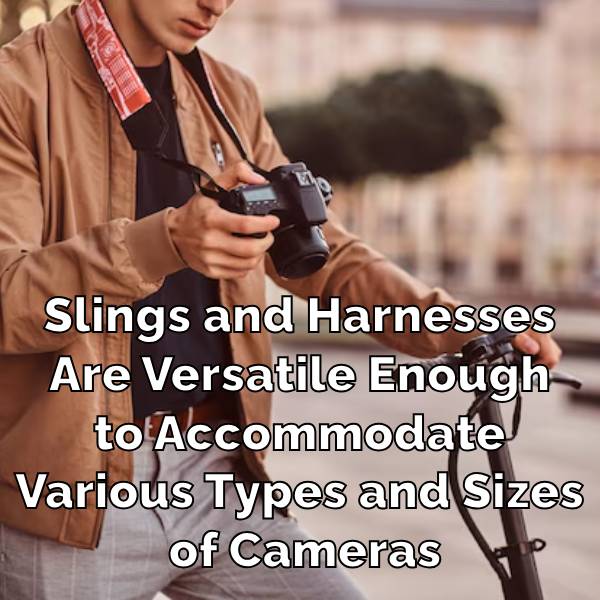
This flexibility makes them an excellent choice for cyclists who may switch between different cameras depending on the trip.
By incorporating a camera sling or harness into your cycling gear, you not only safeguard your camera from potential mishaps but also ensure you’re always ready to capture the perfect shot.
This solution marries the need for quick camera access with the necessity of keeping your gear secure and protected, all while maintaining comfort during your ride.
Reevaluating Camera Choices for Cyclists
When thinking about bringing a camera on your bike rides, it’s worth pausing to reconsider if carrying a full DSLR setup is essential for capturing those moments.
While DSLRs are renowned for their superior image quality and versatility, they also come with a significant weight and size that might not always be ideal for cycling enthusiasts. Let’s dive into some alternatives that could make your ride lighter and more enjoyable.
- Mirrorless Cameras: These have become a favorite among photographers for good reasons. They offer image quality that rivals that of DSLRs, thanks to their advanced sensors and imaging technologies, but in a much more compact and lighter form. This makes them perfect for cyclists. You can easily stow a mirrorless camera in a small bag or even a jacket pocket, ensuring it’s always within reach without weighing you down.
- High-Quality Compact Cameras: Don’t overlook the potential of modern compact cameras. Many models now come with features and image quality that can impress even the most discerning photographers. For cyclists, their appeal is in their size. Being even smaller and lighter than mirrorless cameras, high-quality compact cameras can be effortlessly carried on any ride, making them an excellent choice for those who prioritize convenience but don’t want to compromise on the quality of their shots.
- Reducing Weight and Bulk: The main advantage of opting for a mirrorless or compact camera over a DSLR is the significant reduction in weight and bulk. This not only makes your bike lighter and easier to handle but also reduces the strain on your body during longer rides. You’re more likely to bring your camera along if it doesn’t add much weight, meaning you won’t miss out on capturing those beautiful landscapes or interesting roadside scenes.
- Flexibility and Convenience: Another point to consider is the flexibility these cameras offer. Many mirrorless and compact cameras come with built-in features such as Wi-Fi or Bluetooth connectivity, allowing you to quickly share your photos without needing to carry extra equipment. Additionally, their ease of use means you can capture high-quality images without getting bogged down in settings, making them ideal for capturing spontaneous moments on your ride.
Reevaluating your camera choice for cycling trips means considering what’s most important to you. If capturing high-quality images without the weight and bulk of a DSLR sounds appealing, then a mirrorless or compact camera could be your perfect cycling companion.
This shift not only lightens your load but also ensures you’re always ready to capture the beauty of your adventures, making each ride a photographic journey.
Innovative Carrying Methods
For those who love both cycling and photography, finding innovative ways to carry your camera can significantly enhance your experience. Let’s explore two practical approaches: crafting a DIY solution and opting for specially designed commercial carriers.
DIY Solutions
If you’re someone who enjoys a bit of crafting and customization, creating your own camera carrier can be both rewarding and cost-effective. A popular method involves designing a custom foam insert that fits snugly inside an existing bag or backpack.
This foam insert can be cut out to match the exact dimensions of your camera, lenses, and any other accessories, ensuring everything stays in place, even on the bumpiest of rides. The beauty of this approach lies in its flexibility; you can tailor the insert to suit your specific gear and the bag you prefer to use.
Plus, working on this project can be a fun way to spend an afternoon, resulting in a highly functional and personalized camera-carrying solution.
Commercial Camera Carriers Designed for Cyclists
On the other hand, if you prefer a ready-made solution, the market offers products specifically designed for carrying cameras on bikes. These camera carriers, such as camera cubes, are made to fit perfectly into standard cycling bags or backpacks.
What sets them apart is their cycling-specific features, including waterproof covers to protect your gear from rain and road spray, and shock-absorbing padding that cushions your camera against vibrations and impacts.
These commercial options are ideal for cyclists looking for a reliable and hassle-free way to carry their cameras, offering peace of mind with built-in protection against the elements and road conditions.
Both DIY solutions and commercial carriers have their unique advantages. By choosing the method that best suits your needs, budget, and personal preference, you can ensure that your camera is safely and conveniently transported on all your cycling adventures.
Whether you decide to put your crafting skills to the test or opt for a professionally designed product, the goal is the same: to bring your photography passion along for the ride, capturing those unforgettable moments without compromising on the safety of your gear.
Real-World Cyclist Insights
Tapping into the wisdom of seasoned cycling photographers offers a treasure trove of knowledge for anyone looking to merge their love of biking with photography. A common piece of advice from these experts is the importance of keeping your camera within easy reach.
This approach ensures you can swiftly capture a scene without missing a beat, whether it’s a stunning landscape that suddenly comes into view or an interesting character you encounter along your route. Here’s a deeper dive into why accessibility and quick shooting are crucial, along with additional insights from the field:
- Accessibility: The consensus among experienced cycling photographers is clear – the less time and effort it takes to grab your camera, the more likely you are to capture those fleeting moments that make for compelling images. Whether it’s through the use of a handlebar bag, a camera sling over your shoulder, or a specially designed vest, the goal is to reduce any barriers between you and the shot. This setup not only makes photography more enjoyable but also encourages you to take more photos, improving your skills over time.
- Quick Shooting: The essence of outdoor photography often lies in its spontaneity and the ability to capture the ephemeral. Experienced cyclists recommend having your camera set up and ready to go, with settings pre-adjusted for the current lighting conditions. This preparation allows you to focus immediately on composing your shot, rather than fiddling with settings while the moment passes.
- Practical Gear Selection: Another insight from the field is the importance of choosing gear that complements your cycling and photography style. This might mean opting for a lighter, more compact camera that’s easier to carry and handle or selecting lenses that offer versatility without adding too much weight.
- Protective Measures: Additionally, seasoned cyclists emphasize the significance of protecting your camera from the elements and potential accidents. Using protective covers, ensuring your gear is securely fastened, and having a clear understanding of how to quickly and safely access your equipment can make all the difference in safeguarding your investment.
- Learning from Experience: Finally, a recurring theme is the value of learning from your own experiences. What works best for one person might not suit another, so it’s beneficial to experiment with different carrying methods, camera settings, and equipment to find your ideal setup.
Gathering these real-world insights from cyclists who have mastered the art of on-the-go photography can inspire and guide you in finding the perfect balance between enjoying your ride and capturing stunning images.
Remember, the journey of combining cycling with photography is one of continuous learning and adaptation, filled with opportunities to capture the beauty of the world from the unique perspective of a bike saddle.
Conclusion
Carrying a DSLR camera on a bike doesn’t have to be a cumbersome or risky endeavor. With the right preparation and equipment, you can safely bring your camera along on your cycling adventures, ready to capture the beauty of the world around you.
Having the option of interchangeable lenses, flashes, and other accessories increases your creative options, but you have to be honest with yourself and decide how much you are willing to carry and how likely you are to actually use it.
You may also read – How To Carry A Dog On A Bike?
How to Carry Bike on A Scooter?
The swift agility of a scooter with the pedal-powered pleasure of a bike isn’t just…
Where To Put Keys While Cycling?
Hey there, cyclists! Keys might seem like a simple thing, but listen up – keeping…
How to Lock Multiple Bikes Together?
Heading out with friends or family for a bike ride? Great idea! But let’s not…
How to Carry Boxes on A Bike?
Choosing your bike over a car is kind to the earth because you’re not causing…
How to Carry Musical Instruments on A Bike?
On a venture where the harmony of biking intertwines with the rhythm of music, I…
How to Carry a Yoga Mat on A Bike?
Mixing cycling with yoga offers a unique blend of benefits, including a heart-healthy warm-up from…






